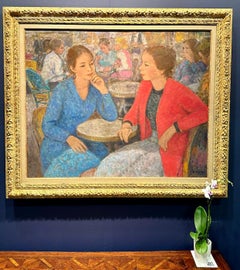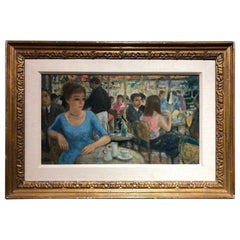François Gall Portrait Paintings
Hungarian-French painter François Gall produced Impressionistic works covering a variety of subject matter. Critics of his day commented extensively on the delicacy of his brushwork, bringing light and color together in his paintings in a harmonious, nuanced manner.
Strongly influenced by French artist Edgar Degas, Gall primarily painted figures, but didn't limit himself to just the human form. Many of his works include countrysides, beaches and city streets.
Born as Ferenc Erdelyi Gall in Kolozsvar (now Cluj Napoca), Hungary, Gall studied under Romanian painter Aurel Popp. In 1932, he showed his work at a Galleria d'Arte Moderna exhibition in Rome.
In 1936, Gall moved to Paris to pursue an artistic career. There, he joined the workshops of French painters Charles-François-Prosper Guérin and André Devambez. In 1937, he exhibited his works depicting his experiences in Paris at the Szalmasy Gallery in Budapest. In 1939, Gall won a silver medal at the Salon d'Asnieres, and he also won a scholarship from the Government of Hungary in that same year.
In 1939, he returned to Hungary for a visit to attend to his sick mother. While away, war broke out in Europe, and he was unable to return to France. Gall served as a medic during World War II, and finished out his service in Austria.
After completing his wartime duties, Gall returned to Paris, where he ultimately became a naturalized French citizen. Although he continued to paint throughout his life, Gall produced his largest body of work in the 1940s, ‘50s and ‘60s. He received numerous awards and showed in many exhibitions, including a permanent installation in Bern, Switzerland.
Gall died of a heart attack in 1987, not long after being elected president of France’s National Union of Painters and Professional Sculptors.
Find original François Gall figurative paintings and landscape paintings on 1stDibs.
1950s Impressionist François Gall Portrait Paintings
Oil, Canvas
1950s Other Art Style François Gall Portrait Paintings
Oil
18th Century Baroque François Gall Portrait Paintings
Copper
Early 20th Century Impressionist François Gall Portrait Paintings
Canvas, Oil
Venice Landscape Italian Oil on Canvas Painting in Gilt Wood Frame, Belle Epoque, Early 20th Century
1980s Impressionist François Gall Portrait Paintings
Canvas, Oil, Cardboard
Early 2000s American Impressionist François Gall Portrait Paintings
Canvas, Oil
17th Century Old Masters François Gall Portrait Paintings
Canvas, Oil
Late 18th Century François Gall Portrait Paintings
Canvas, Oil
1940s Impressionist François Gall Portrait Paintings
Canvas, Oil
Mid-20th Century Impressionist François Gall Portrait Paintings
Canvas, Oil
18th Century François Gall Portrait Paintings
Canvas, Oil
18th Century and Earlier Baroque François Gall Portrait Paintings
Canvas, Oil
15th Century and Earlier Renaissance François Gall Portrait Paintings
Oil, Wood Panel
1820s Old Masters François Gall Portrait Paintings
Canvas, Oil



